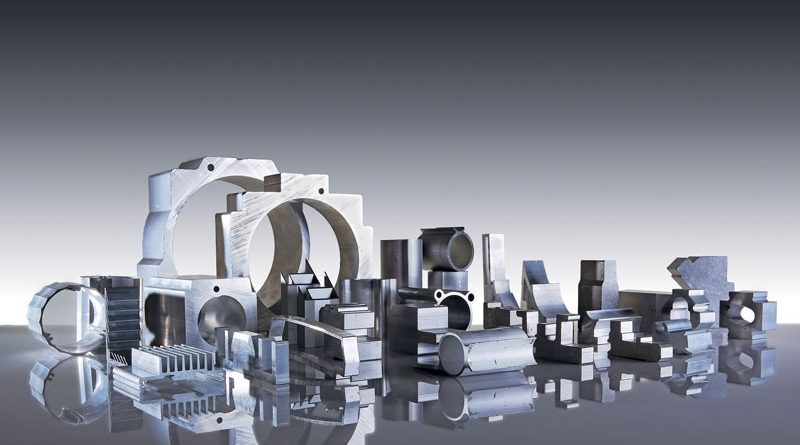Chiari Bruno, The Passion for Entrepreneurship
The pride, strategies and skills of a downstream aluminium SME aiming to grow in quality, eco-sustainability and social responsibility. An interview with Roberta Chiari, who runs the family business together with her sister Daniela, her brother Raffaele and her husband Domenico Codoni
Chiari Bruno, a company founded in 1975 in Chiari, just outside Brescia, now runs its business along two distinct production lines: precision cutting and accessory processing of aluminium extrusions, alongside the time-honoured production of door and window frames and accessories for the building industry, including the production, marketing and installation of aluminium, aluminium-wood, PVC frames and accessories, as well as the production of the Chiariluce line of doors and designer furnishing accessories.
At the company headquarters, we met Roberta Chiari, the founder’s daughter, and talked about the most recent developments in the company’s journey, a path full of events and choices, and characterised by clear objectives: constant attention to the market, commitment to a job made up of content, with optimisation of technologies, products and quality of customer service; at the same time great attention to creating a working environment based on company growth through the appreciation of human resources and improvement of the skills and knowledge of employees and collaborators.
“It all started towards the end of the Sixties”, Roberta Chiari explained, “when my father Bruno, then an employee of a well-known large extruded profile company in the Brescia area, began to take an interest in aluminium windows and doors. At that time, the aluminium window was a new type of application for extrusions and his knowledge of the systems was very appropriately used for technical support and assistance to local customers. One thing led to another, and in 1975 my father decided to set up his own business, founding the Chiari Bruno company and adding to the door and window business the cutting and tumbling of extruded aluminium alloy bars for leading companies, particularly in the automotive sector”.
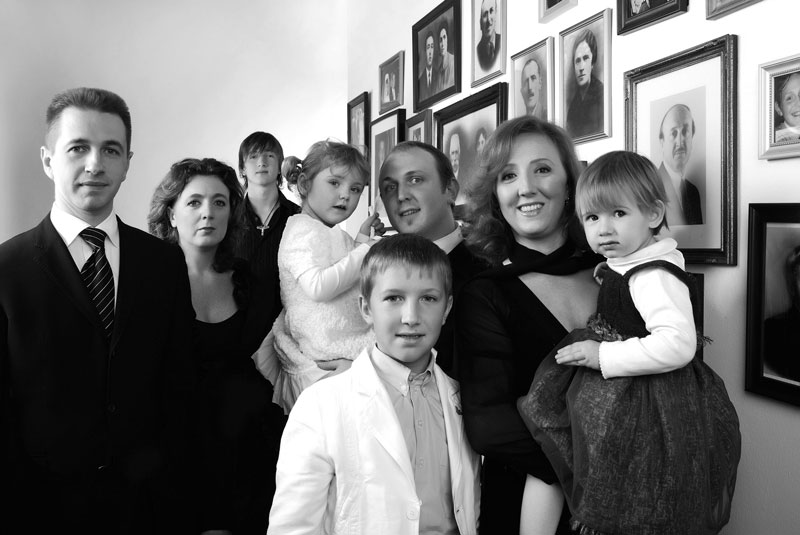
What were the stages in the subsequent development?
“In 2000, after my father passed away, my siblings, my husband and I assumed the leadership of the company, which was already very well established. Our aim was to consolidate our specialisations, working on the quality and reliability of technologies and products and on developing internal skills. A little more than twenty years have passed: at that time the company had about fifteen employees and operated in a warehouse of just over 2,000 square metres, today in our current premises, which date back to 1985 and cover an area of 4,500 square metres, we employ about forty people. We are a typical small to medium-sized company, one of the many which are fortunately plentiful in our country, and we are proud to have put the experience we have been handed down to good use, strengthening the family spirit of this company. Our family business is run by me, who am in charge of the cutting and processing division, my brother Raffaele, who is in charge of windows and doors, my husband Domenico, who is in charge of sales and marketing, and my sister Daniela, who is in charge of logistics. As you can see, the production segments are essentially the same as those from which we started: cutting, tumbling and third-party processing of extruded aluminium alloys on the one hand, and window and door frames on the other. We have a turnover of around 5 million euros, equally divided between the two lines of activity. We have focused strongly on quality, seeking first of all to consolidate knowledge and skills, as well as a solid financial foundation. Our family-run company is also a community extended to all the staff, who participate directly and institutionally in the development of the company’s work projects: the company is an asset for all of us who work there, which we care for and develop together. In our opinion, it should not only be a place of work, but also a tool for improving the quality of people’s lives’.
What are the main distinguishing features of the two segments of your business?
“Regarding the machining of extruded parts, we started with bar cutting and tumbling operations and then developed additional content such as machining with CNC work centres, a choice which has enabled us to broaden our end-use sectors considerably. We have been operating in the automotive supply industry for years, so we are used to being flexible, strictly reliable and effective in moving through difficult times. We are facing the challenges of IATF and environmental certifications, and I would like to add that we have reached an important quantitative milestone, with over 24 million pieces cut and machined, more than twice as many as a decade ago, with constant and significant growth in all target segments, mechanics, transport, furniture, pneumatics, electrical engineering, hydraulics, medical, lighting technology. With many years of experience, full knowledge of the metallurgical and technological context, and operating with a wide range of machines depending on alloys and shapes, we managed to achieve excellence in apparently trivial operations such as cutting. This has actually become a refined technology for us, to the benefit of our customers, enriched by extraordinary cutting precision, very tight size allowances, speed of execution and minimum machining waste. The specialisation acquired in this type of operation, carried out ‘just in time’, adds further value to the final product of the customer, who does not have to keep products in stock and is able to carry out the input and output of goods in a very short time. The reference market for cutting and machining is 100% domestic, where we act as subcontractors: our partners are generally both manufacturers of extruded products and metalworking companies recognised as market leaders, and certainly the majority of the parts we make then go out into the world. It is clear that we have repeatedly set ourselves the medium-term objective of greater direct penetration of foreign markets, which is an interesting point to consider, but not a priority today”.
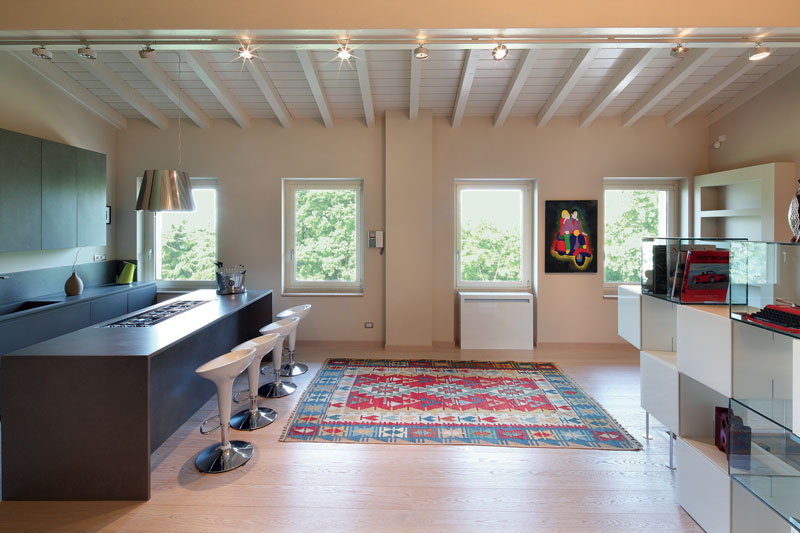
Large-sized lift and slide doors for prestigious homes 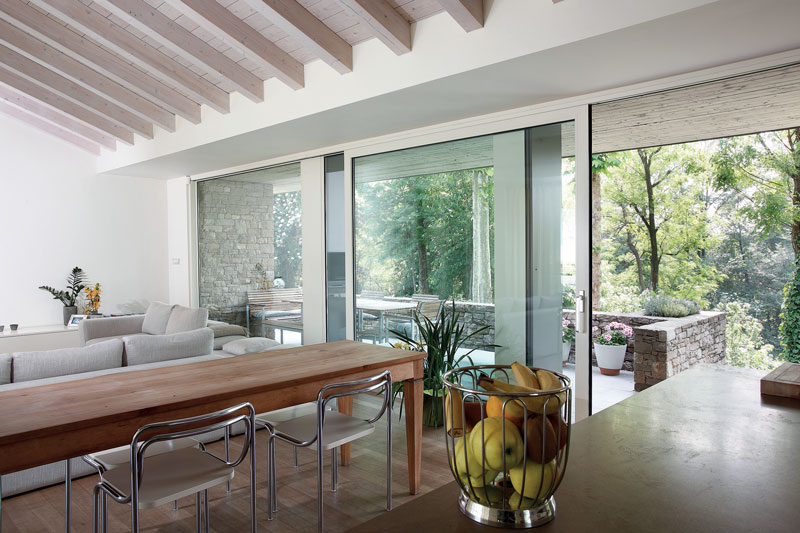
Thermal break aluminium windows with high thermal and acoustic performance 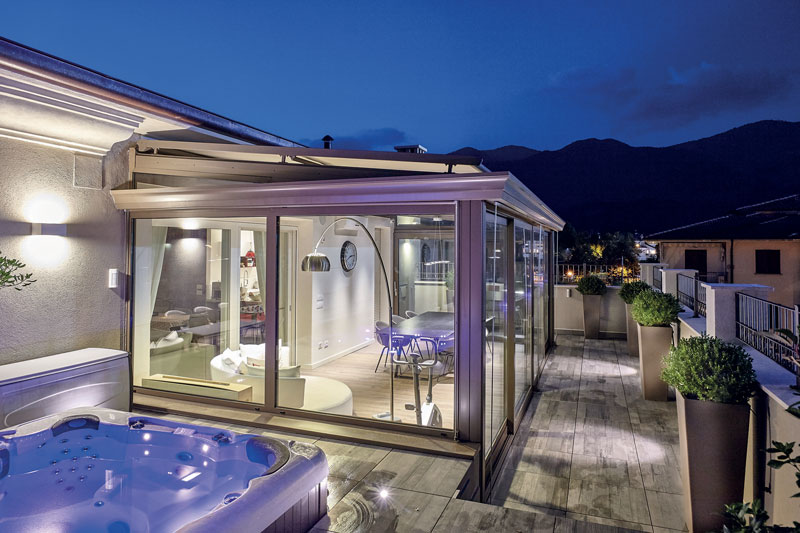
A winter garden in the Pre-Alps near Brescia
And what can you tell us about windows, construction and similar applications?
“Here too, many things have changed over the years, and today our business is concentrated on the medium-high end of the window and door market. We have also entered the area of shutters (sunshades, roller blinds, shutters), and have developed interesting market niches in the field of winter gardens, verandas and bioclimatic greenhouses. Even here the reference market is essentially the domestic one; we operate for more than 50% of the turnover of the building line in the private residential field, 30% in that of public buildings, the rest is fragmented in other end applications”.
How do you approach communication and marketing?
“Our visibility and communication have been based for a long time mainly on word-of-mouth and participation in trade fairs, such as Metef in which we have taken part since the early years of this aluminium-focused exhibition. Having such an international event in Italy is not only an opportunity for a valuable showcase of our capabilities as a country in a fast-developing industrial chain, but it is also an invitation to work as a system to create synergies between complementary companies, an increasingly essential step to remain competitive on the global market. With our construction segment, we have recently enjoyed considerable success on social networks, with tens of thousands of contacts. In this area, we have chosen to generate interest through an extensive catalogue of images from our photo archive, which helps our customers to choose between various solutions”.
You have undoubtedly experienced good company growth, despite going through difficult market periods, but how has the recent pandemic effect impacted on your business?
We know very well that markets, technologies, ways of communicating and business relationships change all the time, so we keep our business structure under constant observation. We have always made good use of less favourable market periods to invest in innovation, both in terms of production technology, with increasingly high-performance equipment, particularly in the post-cutting stages, and in quality control and service development. To name a few examples: we work with procedures and process controls in compliance with sector regulations and ISO 9001:2015, we have been developing Industry 4.0 solutions for some 20 years now, and we have invested heavily in digitalisation, increasing the connection between the production department and the management offices. For us, Industry 4.0 is a fundamental factor for transformation and improvement in the area of production processes and optimal work organisation, in improving quality and in using resources more efficiently. Regarding logistics, we have for several years now activated a series of smartphone applications dedicated to customers, with the booking of pick-up slots, so that shippers and customers’ drivers can access a small portal and avoid wasting time.
Concluding briefly on the impact of the pandemic, I must say that despite a total forced shutdown of three weeks, we ended last year with a drop in turnover limited to less than 14%, and with a still positive economic result, also due to new opportunities which opened up in the medical sector”.
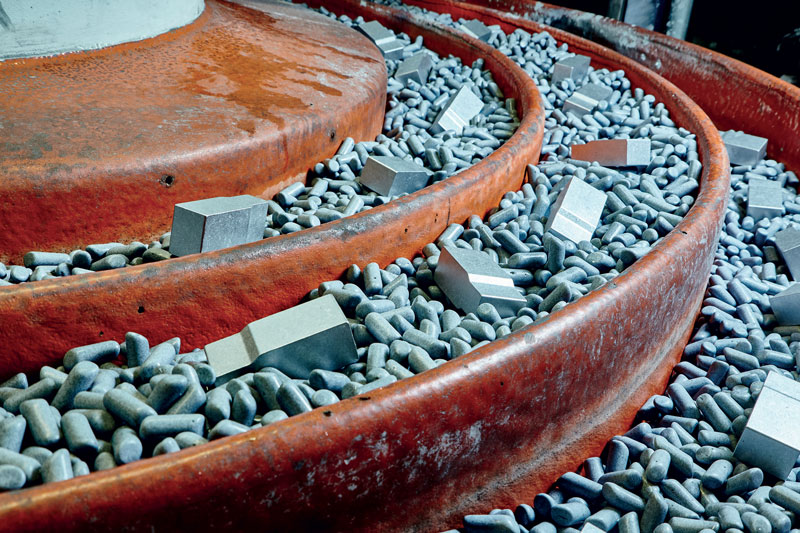
As a company downstream from the initial
aluminium processing, you are now in an excellent position because the light metal industrial chain is considered to be expanding strongly in the coming years, considering the great versatility and eco-sustainability of the material. Taking this situation into account, how do you see your company’s future and where do you think the market of your interest could be in the next few years?
“Let’s say straight away that everything has changed in just a few years. For example, the growth of aluminium parts and components in transport vehicles has been spectacular in recent years, because the use of the light metal as an alternative to other materials is technically correct and economically advantageous; the average aluminium content per vehicle in Europe was 50 kg in 1990 and is expected to exceed 200 kg by 2025, an important figure which has meant the opening up of completely new sectors. We have also seen in numerous articles in your magazine that there is great attention especially in Europe paid to aluminium as a champion of sustainability and eco-sustainability, and this is a fact we are very pleased to note, because we are proud to state that our corporate philosophy has always been to believe in the social values of business in all aspects. We like to be positive, which is why we appreciate the EU’s industrial renaissance plan focusing heavily on sustainability, on local concerns, on small and medium-sized companies, on the Green Deal which favours light metal as a champion of resource saving, environmental protection, recycling and the circular economy. As far as we are concerned, we know aluminium well, it is our heritage of culture and competence on which we have built our family business, conceived as a real community based on an excellent company climate, made up of valid and satisfied people, with whom we have shared and pursued company objectives with transparency and determination; for this reason we are prepared for a future based on competitiveness, confident that we shall be able to interpret the needs of our end users with quality services suited to the new challenges”.

